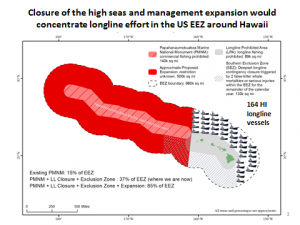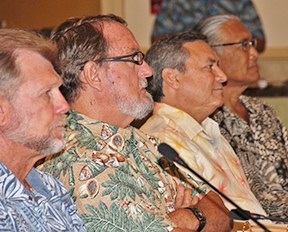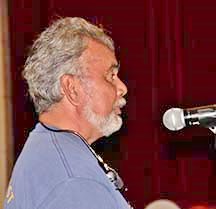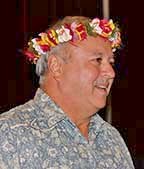HONOLULU (13 June 2016) The Western Pacific Regional Fishery Management Council concluded its 166th meeting Friday at Tumon Bay, US Territory of Guam, with discussions focused on the challenges of keeping the tradition of fishing alive in the US Pacific Islands.
During public testimony, Manny Duenas, a former Council chair and long-time president of the Guam Fishermen’s Cooperative Association, covered a gamut of issues facing Guam’s fishermen, including competition with purse-seiners for tuna; tiger shark attacks on net fishermen; competition with Micronesian fishermen from the US Freely Associated States who reside on Guam; the inability to continue sociocultural traditions related to sharing of green sea turtle; and the threat of losing prime fishing grounds due to military buildup, among others.
Duenas recited arguments by the US Congress during the ratification of the Treaty of Paris of 1898, which ceded Guam, Puerto Rico and the Philippines to the United States, implying the statements are still applicable today.
This Treaty will make us a vulgar, commonplace empire, controlling subject races and vassal states, in which one class must forever rule and other classes must forever obey. -Sen. George Frisbie Hoar
Providence has given the United States the duty of extending Christian civilization. We come as ministering angels, not despots. -Sen. Knute Nelson
 Council Members from Hawaii also expressed concerns about the future of fisheries in their islands and the lack of local resident control, particularly in regards to the proposed expansion of the Papahanaumokuakea Marine National Monument (MNM) in the Northwestern Hawaiian Islands (NWHI). The proposal would increase the monument fivefold from 140,000 square miles to 625,325 square miles. From a fisherman’s perspective, it could reduce the available fishing grounds in the US exclusive economic zone (EEZ) waters around Hawaii from 63 percent to 15 percent.
Council Members from Hawaii also expressed concerns about the future of fisheries in their islands and the lack of local resident control, particularly in regards to the proposed expansion of the Papahanaumokuakea Marine National Monument (MNM) in the Northwestern Hawaiian Islands (NWHI). The proposal would increase the monument fivefold from 140,000 square miles to 625,325 square miles. From a fisherman’s perspective, it could reduce the available fishing grounds in the US exclusive economic zone (EEZ) waters around Hawaii from 63 percent to 15 percent.
“The density of hooks in the remaining EEZ left open around Hawaii would be immense,” noted Council senior scientist Paul Dalzell.
“The average depth of the proposed expansion is 3 miles deep,” Council Chair Edwin Ebisui Jr. pointed out. “Fishing boats wouldn’t even cast a shadow on the bottom … Where is the conservation benefit? The only effect of expansion is detrimental effects to economy, food security and food production.”
Ebisui recalled that when the NWHI monument was first established it overlay the Protected Species Zone that the Council had established in the early 1990s, within which longline fishing was prohibited. “It is a validation that what the Council did 15 years prior to the designation of the monument was something correct.”
While longline fishing was prohibited in the Protected Species Zone, about 15 bottomfish vessels with a maximum vessel length of 60 feet were permitted to fish in the waters. When the monument closed the waters to the bottomfish fishermen, the pro-monument supporters said it was no big deal, Ebisui recalled. But it was a big deal, he added, as that fishery provided 50 percent of the locally landed bottomfish. Ebisui said the monument supporters said you can import. “And we do,” he added, “from Indonesia,” a country renowned for enslaving fishermen. “By encouraging imports we are encouraging Illegal, Unreported and Unregulated (IUU) fishing and slave fishing,” Ebisui said. “Why are we doing that and hamstringing our own domestic, clean fisheries? The picture does not make sense.”

From left: Council Vice Chairs McGrew Rice and John Gourley, Gov. Eddie Calvo of Guam, Council Chair Edwin Ebisui Jr.
Ebisui said that at a recent meeting with the White House’s Council on Environmental Quality (CEQ), the Fishery Council was told that there is a vast distinction between preservation under the Antiquities Act, which allows the US President to proclaim a national monument, and conservation and management under the Magnuson-Stevens Fishery Conservation and Management Act (MSA). Ebisui said the Council asked the CEQ representatives, “Will there be a point under Antiquities Act for science, reality and fact?” Ebisui said, they didn’t respond, which he took to mean that science, fact and national and public benefit does not matter.
“What this looks like is the beginning of the dismantling of MSA,” predicted Council Vice Chair McGrew Rice (Hawaii). “What we will have in Hawaii is protected species. Our commercial fishery will be gone.”
“Truth is these monuments have nothing to do with conservation,” said Council Vice Chair John Gourley from the Commonwealth of the Northern Mariana Islands (CNMI). “It is mainland politics that one person before he leaves office can designate these at no cost, with no National Environmental Policy Act and no Congressional oversight, to pay off the environmentalists for their legacy.”
“We had our fill with the Pew [Charitable Trusts],” Gourley added. “They manipulated data, they lied… it was amazing the misinformation they provided to the people of the Marianas to trick them to go along with the [Marianas Trench] monument.”
Council member Taulapapa William Sword of American Samoa echoed similar concerns. “American Samoa is very afraid as I’m sure they are here in the Marianas that these folks will run all over us.” The Antiquities Act was used to create the Rose Atoll Marine National Monument, encompassing 10,156 square nautical miles and overlaying the Rose Atoll National Wildlife Refuge. The Territory also in 2012 saw the national marine sanctuary in American Samoa expand from 0.25 square mile to 13,581 square miles.
The US Pacific Islands accounts for virtually all of the nation’s no-take marine protected area (MPA) waters. In addition to no-take MPAs within EEZs, environmental groups are encouraging the designation of 30 percent of the high seas as no-take MPAs through an international legally binding instrument under the UN Convention on the Law of the Sea on the conservation and sustainable use of marine biological diversity of areas beyond national jurisdiction.
After deliberating, the Council voted to relay its concerns to the Department of State regarding the UN proposal for high seas MPAs, as it would further close off available fishing grounds. The Council has already written to President Barack Obama opposing the proposed NWHI monument expansion.
The Council additionally made the following recommendations regarding Hawaii, pelagic and international fisheries, among others:
- To ask the National Marine Fisheries Service (NMFS) Pacific Islands Fisheries Science Center to develop a study of the socioeconomic impacts on the Hawaii bottomfish fishery by the State’s Bottomfish Restricted Fishing Areas, which straddle state and federal waters.
- Ask NMFS Pacific Islands Regional Office (PIRO) to expedite completion of the administrative process needed to specify the 2016 Participating Territory bigeye specifications under the Amendment 7 framework of the Pelagic Fishery Ecosystem Plan so as to avoid an implementation lag, which resulted in a two-month closure of the fishery last year. Current forecasts suggest the Hawaii longline fishery may reach the US quota of 3,554 metric tons in the Western and Central Pacific Ocean between late July and mid-August. Amendment 7 would allow the US Pacific Territories to transfer a portion of their bigeye quota to federally permitted longline vessels in Hawaii.
- Ask that NMFS provide a full presentation on the impact of Effort Limit Area for Purse Seine (ELAPS) on the American Samoa economy as soon as reasonably possible. NMFS reported that preliminary results suggest that there were impacts from the closure on the American Samoa economy and a connection between US purse-seine vessels and the broader American Samoa economy.
At the close of the meeting, the Council recognized outgoing Council member Taulapapa William Sword of American Samoa, who has completed the allowable three consecutive three-year terms on the Council.
Recommendations by the Council that are regulatory in nature are transmitted to the Secretary of Commerce for final approval. The Council was established by Congress under the Magnuson-Stevens Fishery Conservation and Management Act in 1976 to manage domestic fisheries operating seaward of State waters around Hawaii, American Samoa, Guam, the CNMI and the US Pacific Island Remote Island Areas. For more information on the Council meeting, go to www.wpcouncil.org or email info.wpcouncil@noaa.gov.
Western Pacific Regional Fishery Management Council: Appointees by the Secretary of Commerce from nominees selected by American Samoa, CNMI, Guam and Hawai`i governors: Michael Duenas, Guam Fishermen’s Cooperative Association (Guam) (vice chair); Edwin Ebisui Jr. (Hawaii) (chair); Michael Goto, United Fishing Agency Ltd. (Hawaii); John Gourley, Micronesian Environmental Services (CNMI) (vice chair); Julie Leialoha, biologist (Hawaii); Dr. Claire Tuia Poumele, Port Administration (American Samoa); McGrew Rice, commercial and charter fisherman (Hawaii) (vice chair); and William Sword, recreational fisherman (American Samoa) (vice chair). Designated state officials: Suzanne Case, Hawai`i Department of Land and Natural Resources; Dr. Ruth Matagi-Tofiga, American Samoa Department of Marine and Wildlife Resources; Richard Seman, CNMI Department of Lands and Natural Resources; and Matt Sablan, Guam Department of Agriculture. Designated federal officials: Matthew Brown, USFWS Pacific Islands Refuges and Monuments Office; Michael Brakke, US Department of State; RADM Vincent B. Atkins, US Coast Guard 14th District; and Michael Tosatto, NMFS Pacific Islands Regional Office.
Click here for printable PDF


